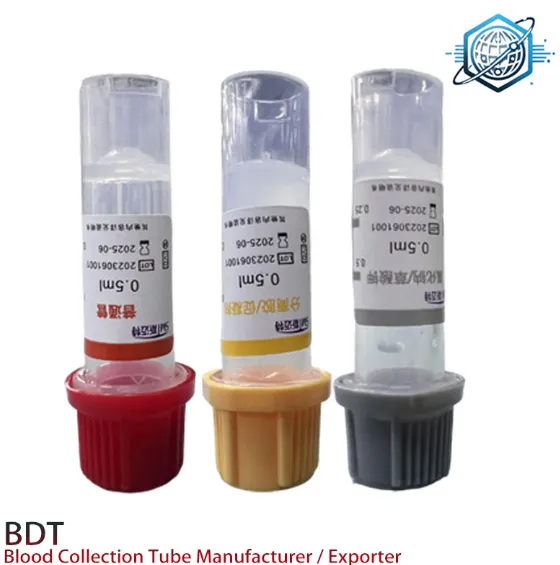Jul . 02, 2025 15:07 Back to list
Understanding the Use of Plain Tubes for Blood Collection in Clinical Practice
Blood collection is a fundamental step in medical diagnostics, providing crucial samples for a wide range of laboratory tests. Among the various collection devices, plain tubes for blood collection hold a special place for tests that require serum samples. These tubes, often referred to as plain vacutainer or plain vacuum tube, are designed to facilitate easy and effective blood draw without anticoagulants. Understanding their composition, function, and applications is essential for healthcare professionals to ensure accurate and reliable test results. This article delves into the characteristics and uses of plain vacutainer tubes, focusing particularly on the widely used red plain tube.

What Are Plain Tubes for Blood Collection and How Do They Work?
Plain tubes for blood collection are blood collection devices that contain no anticoagulants or additives that prevent clotting. Instead, they may contain clot activators to expedite the coagulation process. These tubes are essential for obtaining serum, the fluid portion of blood after clotting, which is used for many biochemical and serological tests.
Features of Plain Tubes:
No anticoagulants: Allows the blood to clot naturally, separating serum from blood cells upon centrifugation.
Clot activators: Some plain tubes include clot activators such as silica particles that accelerate clotting, improving turnaround time.
Vacuum sealed: The term plain vacutainer or plain vacuum tube refers to the vacuum inside the tube that automatically draws the correct volume of blood, minimizing error and contamination.
The use of plain vacutainer tubes ensures a clean serum sample free of clotting factors, making them suitable for tests like liver function, kidney function, and hormone assays.
The Role and Significance of the Red Plain Tube in Clinical Settings
One of the most recognizable and widely used plain tubes is the red plain tube. The red cap signifies a tube free of anticoagulants and often with a clot activator inside.
Clinical Importance:
Serum collection: The red plain tube is primarily used for tests that require serum, such as chemistry panels, serology tests, and therapeutic drug monitoring.
Faster processing: With clot activators, the red plain tube reduces the clotting time compared to plain glass tubes without additives.
Sample integrity: The absence of anticoagulants ensures that the sample reflects true serum analyte levels, which is vital for accurate diagnostics.
Healthcare providers rely heavily on the red plain tube due to its versatility and reliability in routine blood testing.
Comparing Plain Vacutainer Tubes with Other Blood Collection Tubes
In clinical laboratories, selecting the right tube is crucial for obtaining the desired blood component and maintaining sample integrity.
Plain Vacutainer Tubes vs. Anticoagulant Tubes:
Plain vacutainer tubes produce serum after clotting, ideal for biochemical assays.
Tubes with anticoagulants (e.g., EDTA, citrate, heparin) prevent clotting to preserve whole blood or plasma for hematology or coagulation studies.
Benefits of Using Plain Tubes:
Ease of use: Vacuum ensures consistent sample volume and easy draw.
Reduced contamination risk: Sterile, sealed tubes minimize exposure.
Versatility: Suitable for a wide range of tests requiring serum.
Understanding when to use a plain vacuum tube versus other types is essential for ensuring sample validity and accurate laboratory analysis.
Plain tubes for blood collection, including the popular plain vacutainer and red plain tube, are indispensable tools in clinical diagnostics. Their design facilitates efficient blood draw and optimal serum separation, making them ideal for a broad spectrum of tests. Recognizing the differences and appropriate applications of plain vacutainer tubes versus anticoagulant tubes ensures better sample quality and more reliable results.
For healthcare professionals, mastering the use of these tubes directly impacts diagnostic accuracy and patient care outcomes. If you need further information on blood collection techniques or specific tube recommendations for particular tests, feel free to ask.
-
Soothe, Relax, Heal—Discover the Power of the Neck and Shoulder Heating Pad
NewsJul.02,2025 -
Soothe Foot Pain and Restore Comfort with the Advanced Electric Foot Warmer
NewsJul.02,2025 -
Discover the Ultimate Comfort with the Advanced Full Body Heating Pad
NewsJul.02,2025 -
Understanding the Role of Plain Serum Tubes in Clinical Diagnostics
NewsJul.02,2025 -
The Role of Battery Operated Electric Blankets in Modern Healthcare and Wellness
NewsJul.02,2025














